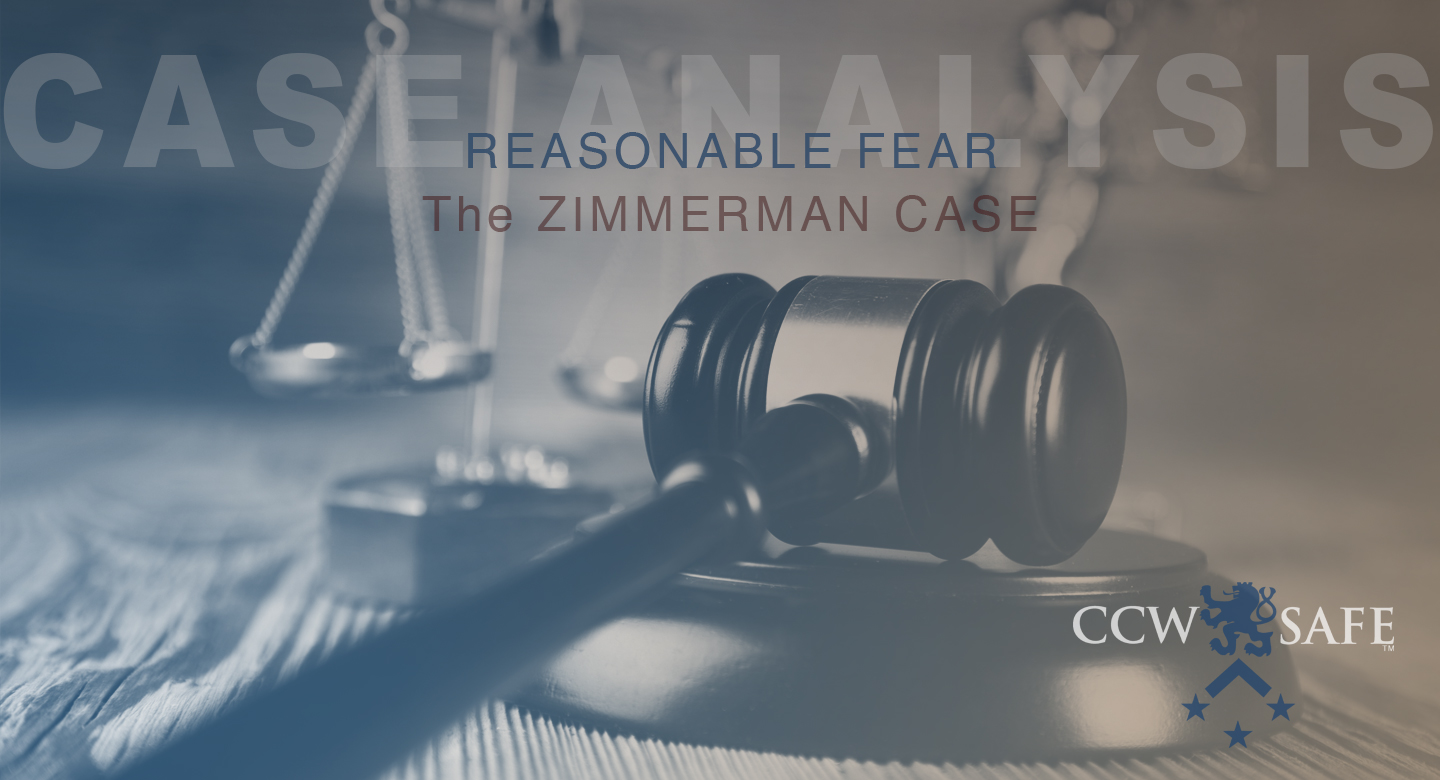
Posted on December 7, 2017 by support@ccwsafe.com in Case Analysis
Legal Case Analysis: The Zimmerman Case- Reasonable Fear
Zimmerman Case: Episode 4 — Reasonable Fear
Central to every self-defense case is the concept of “reasonable fear.” Before deploying deadly force, an individual must believe that the threat of great bodily harm or death at the hands of another is imminent. Anyone tasked with assessing whether a fear is reasonable will judge a self-defense scenario two ways: they will decide if fear was reasonable for the shooter; and they will decide if a hypothetical “reasonable man” would have experienced justifiable fear in the same situation.
In the Zimmerman case, George Zimmerman encountered Trayvon Martin in a dark, relatively isolated pathway between two rows of townhomes. They were alone. Evidence suggests that Martin punched Zimmerman in the nose and wrestled him to the ground, where Martin climbed on top of Zimmerman and continued to strike blows to Zimmerman’s head and face. The beating lasted for at least 45 seconds.
The recording of a 911 call placed by a witness from the nearest townhome captured shrill cries for help. While prosecutors contested Zimmerman’s claim that the cries were his own, evidence leaned strongly in his favor, and the audio left little doubt that the person screaming was experiencing legitimate terror.
During the altercation, John Good opened the backdoor of his home and witnessed the fight, and he testified that Zimmerman was on the bottom being beaten by Martin. Zimmerman saw Good, and hoped that he would offer help, but when Good went back inside and closed the door, the hope of help vanished, and exaggerated Zimmerman’s fear of continued bodily harm.
The Unarmed Decedent –– Disparity of force
The fact that Trayvon Martin was unarmed provided a major challenge to Zimmerman’s self-defense claim. A practical assessment of “reasonable fear” requires a proportionality of response. In the Zimmerman case, the Martin family attorneys famously publicized that Martin was armed only with “ice tea and Skittles,” and the defense faced public sentiment that Zimmerman “brought a gun to a fist fight.”
From this perspective, the specific details of Zimmerman’s situation at the moment he pulled the trigger became very important. Had Zimmerman been standing the moment he fired the fatal shot — which is what some initial press reports suggested — a jury would have been far less likely to have found the use of force as justified. Fortunately for Zimmerman, eyewitness testimony corroborated his claim that he was on his back when Martin climbed on top of him. Likewise, forensic evidence reinforced Zimmerman’s account of the events.
Ultimately, a jury had to consider that Zimmerman had been physically overpowered and was enduring a continued beating with no indication that it would stop when he fired.
Martial Arts Training
Another important issue that arose at trial was that Zimmerman had received instruction in mixed-martial arts. If Zimmerman had been proficient in hand-to-hand combat, a jury would have been far less-likely to excuse the disproportionality of force used. This is a good example of the difference between applying the “reasonable man” standard and judging an individual on his specific experience and training.
At trial, Zimmerman’s martial arts instructor testified, describing him as “soft.” His testimony left the jury with the impression that, while Zimmerman had trained in martial arts, he wasn’t very good at it.
Another factor that helped the defense surmount the disproportionality of force issue was that the gun did not become a factor until well into the encounter. In a recorded statement to investigators, Zimmerman claims that during his struggle with Martin, his shirt rode up — exposing the pistol. Had Martin reached the gun before Zimmerman, it very well could have been used against him. By gaining control of the weapon and using it, Zimmerman prevented his assailant from getting it first.
Readiness of the Weapon
Like most concealed carriers, Zimmerman chose to carry his pistol with a round chambered. That means, of course, that to fire the weapon, all Zimmerman had to do was squeeze the trigger. If Zimmerman had to chamber a round, in all likelihood, he wouldn’t have been able to use his weapon in self-defense.
If he had managed to chamber a round and fire, prosecutors may have argued that Zimmerman could have used those efforts to fight back in other ways; they could have suggested that racking the gun gave him time to reflect on what he was about to do. Both scenarios would have complicated the self-defense argument at trial.
It is important for concealed carriers to get the training and carry the gun the way it’s designed to be used. If you don’t, you may not be able to defend yourself, and if you are, the very act of making it operable, may give the prosecutor ammunition opportunity to claim you had the intent.
Find the kind of weapon the strikes a balance between your safety and readiness concerns. Remember that every step made to ready the weapon creates an opportunity to judge the shooter on the imminence of the threat.
Editors Note: Not all the views in this article reflect the views of CCW Safe.
-

-
Mike Darter
Mike was a police officer in Oklahoma City from 1991-2001, and a federal contractor for the DOJ from 2001-2011. During his career, Mike investigated and testified in hundreds of violent crimes, including shootings, homicides, and other violent felony crimes. Mike was involved in a shooting as a police officer and went through a lawsuit from that shooting. The lawsuit was later dismissed, but his experience is what led to the creation of CCW Safe.